Blog
Top 5 Non-Crunchy Ab Moves!
Crunches are often thought of as the most simple, easy-peasy, go-to exercise for your belly muscles. Turns out, crunching requires a fair amount of technique, especially when a diastasis recti gap is present. Done poorly and in high reps, they typically bulge the very area you may be trying to flatten.
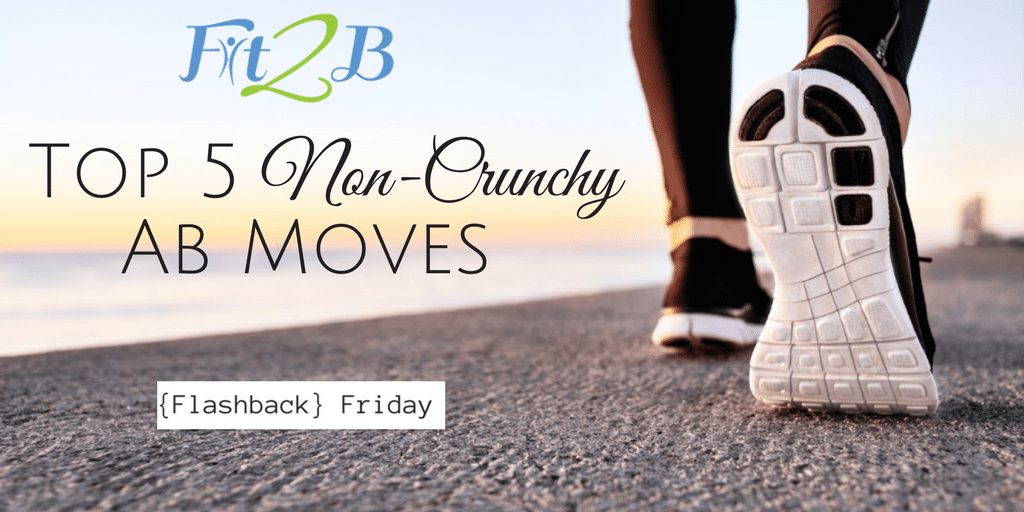 I’d like to offer five accessible exercises that can help diminish some of that extra roundness that makes you look pregnant when you’re not. Not that we’re opposed to curves around here! I’ve got a few natural ones myself because my body will always be postpartum, and I welcome the changes that don’t indicate dysfunction.
I’d like to offer five accessible exercises that can help diminish some of that extra roundness that makes you look pregnant when you’re not. Not that we’re opposed to curves around here! I’ve got a few natural ones myself because my body will always be postpartum, and I welcome the changes that don’t indicate dysfunction.
I’m happy with my stretch-marks and wider hips, but a dysfunctional pelvic floor and core with diastasis recti? No thanks! Those are aspects of womanhood that I’d like all of you to know you can ditch!
Wait—Why No Crunches?
Because, if you’re dealing with untreated diastasis recti, hernia, prolapse, or any other core issue that hasn’t been addressed or resolved, you need rehab, not crunches. Without the foundational + functional strength required, crunches can make your injuries and dysfunction worse, causing you to take two steps back and zero steps forward.
The video below will demonstrate and discuss that more in-depth, but allow me to spell it out here, too:
- Crunches imitate slumped posture: When the head and shoulders lift off the ground, that’s the same position as when you slouch in a chair, only from a different angle. Most of the women I serve here on Fit2B are spending enough time hunched over their children while mothering, so I focus on elongation, alignment, and stabilization. It’s not that we can NEVER flex the spine, but doing a bunch of crunches won’t solve this issue.

- Crunches can bulge the belly: Do a lazy crunch. But just one. Does your belly go in or out? One of the most basic principles of fitness is that “form follows function.” Maybe your mother was like mine, and she told you that if you made a certain face long enough, it would stay that way? Same concept. Train how you want to look. If you want a flatter stomach, and doing a curl-up (another word for crunch) makes your belly poof outward, then it’s time to join Fit2B. Our videos will teach you strategies for properly recruiting your core + whole body!
- Crunches do not help diastasis recti: Having a thinning and separation of the fascia in the center of your abdominal wall is pretty common, especially after having children. When your “fupa” fascia isn’t transmitting load correctly – and when you don’t know how to engage your abs right, your belly may pooch out more when you’re cranking out crunches. This very recent 2023 study by Gluppe et al proved that “curl-ups” (aka: crunches) did not improve Diastasis Recti in postpartum women.
- Crunches focus on one portion of your abs: But your abs have FOUR layers, and I can think of MANY exercises that work all the layers at once! Do you have time to work every single muscle in your body individually? Ha! I don’t, and neither do most busy moms! Your abs have four distinct layers, and I’ll happily show you how to work them all along with the rest of your body here in our Fit2B home workout videos
- Crunches can compress your intervertebral discs: With 40% of people over age 40 having degenerative disc disease. Dr. Stuart McGill, in his book The Back Mechanic offers evidence from his 30+ years of research and clinical experience studying the impact of crunches and sit-ups on human and animal spines. We need to be doing exercises that decompress the spine, not compress it!
I know, I know . . . Many of you have been taught to default to doing crunches your whole life! They’re in just about every media picture of ab work in mainstream magazines and even fitness textbooks! Having built this website, I can vouch for how hard it is to find stock photography without them—and with clothes.
Without crunches. With clothes.
Is that too much to ask? Yes?
Fine, I’ll make my own!
Oh, wait . . . I already did! Haha!
So, about those 5 moves . . .
Okay, so crunches are out. Situps are definitely out. Planks are also tricksy when diatasis recti is present. So what’s a person to do? How can you un-muddle your middle without buying into some weird gimmick, pill, or lotion?
First and foremost, if you haven’t already, please look into physiotherapy (as they call it up north of me and overseas) or physical therapy with a specialist like this one, or read this to find one in your area.
After you’ve been booked in for that life-changing help, please consider joining us here at Fit2B for everything from beginner to challenging workouts that will help you connect to your deep core muscles without undoing the valuable work of your specialist. I coordinate carefully with several women’s health physiotherapists (WHPT) to be sure Fit2B stays between the lines and builds on what they do with my clients.
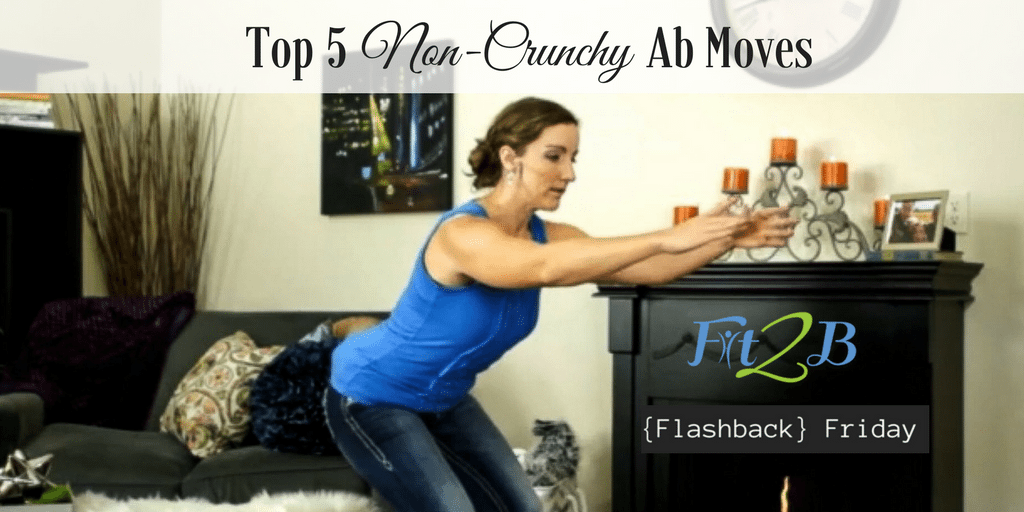 My 5 Fave Non-Crunch, No-Sit-Ups-Needed Ab Exercises
My 5 Fave Non-Crunch, No-Sit-Ups-Needed Ab Exercises
For the sake of everyone everywhere, this shortlist of five of my favorite core-activating exercises can be done just about anywhere, anytime. Really, I can think of hundreds beyond this list, which is why I’m always filming new total-body tummysafe workouts for this website you’re on right now, but I wanted this list to be as accessible as possible.
#1: Proper Breathing
Perhaps you’ve never thought of breathing as a type of exercise, but the way you breathe can get seriously messed up when you’re dealing with deep dysfunction. A huge part of my approach to fitness involves strategic breathing and alignment during all the workouts on Fit2B to allow for the best core recruitment. Physiological breathing requires a major amount of movement and work in your whole core. The terms I use on Fit2B are “core breath” or “belly breath” and a few others like them in the Fit2B Basic Breath Work video that I posted on my YouTube channel.
#2: Walking
Really, not running? No, not if you have a distended diastasis belly bumping around, and definitely not if you’re experiencing any leaking.
Walking can actually burn more calories than jogging, and it works the entire core: glutes, pelvic floor, abs, hips, EVERYTHING! I’m such a fan of walking that I’ve created a whole mini eCourse called Walking As A Workout.
#3: Squatting
I could write a lot about how squats recruit your abs and pelvic floor, but I already did, so feel free to click here and read all the little things about squatting + watch yet another awesome video from us!
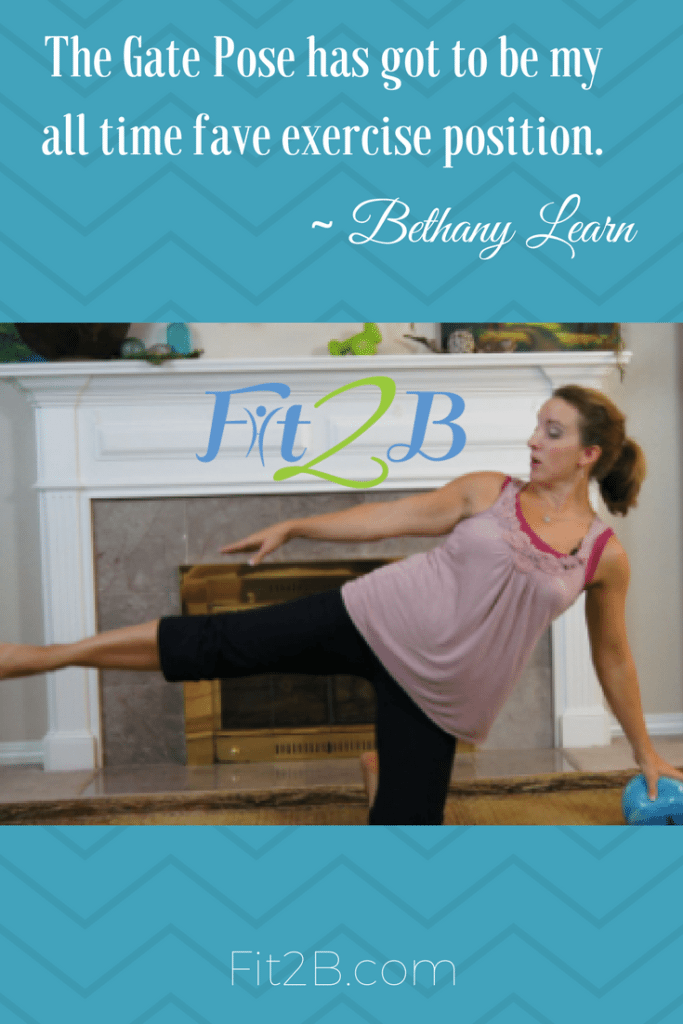 #4: Gate Pose
#4: Gate Pose
The Gate Pose has got to be my all time fave exercise position, and it gets a lot of use in my workout videos here at Fit2B Studio because it works your obliques without twisting them, which can be problematic for those in the early phases of healing their diastasis recti. Later, it’s fine—again, with proper technique, which I will teach you in our workouts here on Fit2B. It’s also such a great springboard move into other motions. For example, I love adding side-leg Pilates motions to it and playing with the angles of the arms and legs.
#5: Hula Hooping
Using a basic or lightly weighted hula hoop can be a fun workout, and this upright exercise forces kids of any age to draw their navel slightly inward to create a place for the hula hoop to rotate about their midsection. The gentle motion is awesome for your legs, hips, glutes, AND arms since it’s impossible to hula hoop with your arms relaxed. Skip the weighted hoop if your diastasis recti (DR) is still healing. Check out this cardio routine we filmed with Kelly Dean of the Tummy Team that uses a hula move.
More Core Alternatives
You might find yourself in a group fitness training situation where everyone is being led to do crunches, sit ups, or planks when you know your body isn’t ready. When the fascia of your abs isn’t ready to generate tension against the pressure of those moves yet, that’s where this video comes in handy.
.
Check out these vintage Fit2B pics from the original article!
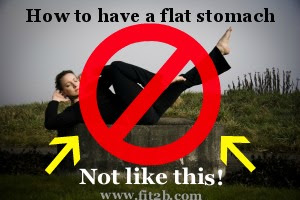
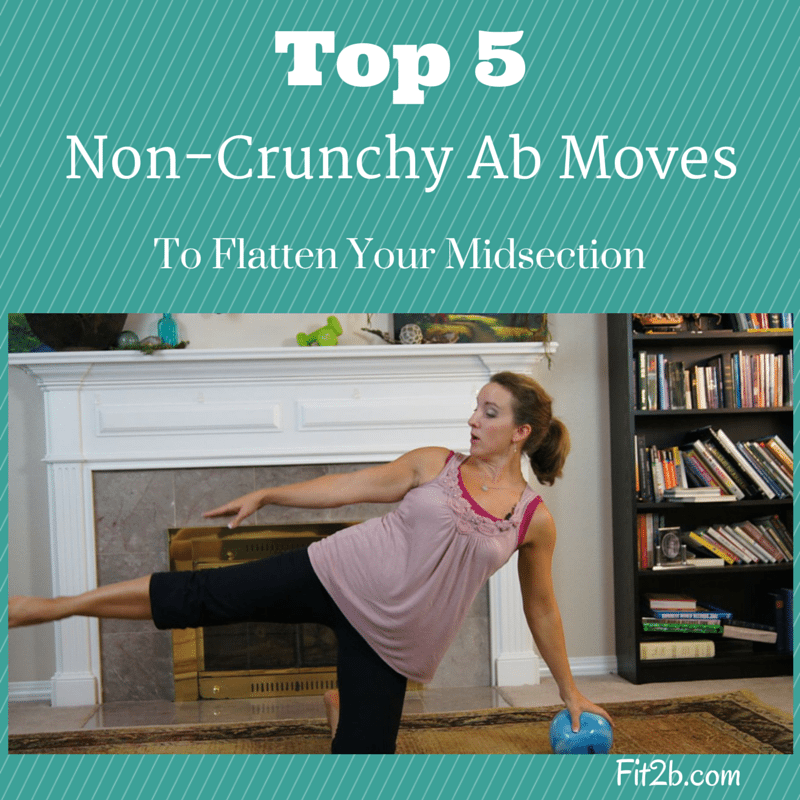

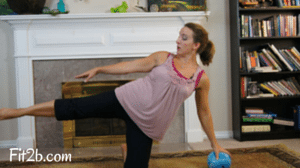


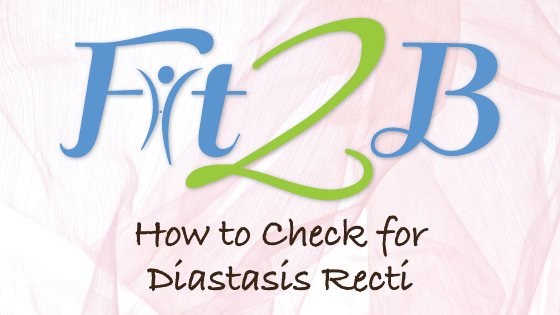
This is great. I teach dance and somatics at a university and I’ve spent a lot of energy trying to convince my students that crunches are not the way to go. Amen!
If you would allow me to offer up some comments I had a couple quick thoughts/counter points to consider on crunches doing more harm than good. The fitness industry has put crunches under a good deal of scrutiny which is mostly driven from extrapolation and misinterpretation of the research/information. Like all exercise there is always cost and benefit….. the discussion should move from should we crunch or not … to FOR THIS INDIVIDUAL at this point in time and under these set of circumstances and with this progression this is how we would want to perform resisted spinal flexion (if at all). (which by the way is how the industry should think about all exercise not just a crunch…..)
– your point on posture…… why would it be that crunches are the only exercise that would cause such a dramatic change in “posture”? I perform elbow flexion under load quite frequently and have never had to worry about my elbow being stuck in a flexed position. I perform resisted “spinal” extension quite frequently and have never had to worry about being stuck in a gross position of extension? I perform resisted humeral extension with scapular retraction(rows) and never have to worry about my scapula being stuck in a retracted position. I also perform hip extension quite frequently and have never had to worry about it keeping my posture stuck either. IN fact while seated in a spinal flexed position at a desk under the load of gravity my abdominals have to do every minimal work at all and it is in fact my spinal extensors that are fighting gravity (and all my other various back musculature…scapular retractors and elevators.)… so maybe I want to do crunches or any other resisted anterior trunk musculature challenge to keep that area strong.
—-your point on a bulging abdomen… a muscle can only generate tension. The rectus abdominis for example has an attachment on the pubis and another attachment on the Xiphoid process and the cartilage of ribs five through seven. (Joseph Muscolino, the muscular system manual 3rd ed.) As the muscle can only generate tension it can only pull from one attachment to the other in a straight line (not perpendicular to its muscle belly). Given an anatomical starting position the shortest distance would pull the rib cage down toward the pubis….it would be quite a feat for the muscle to pull out and away from the rib cage. Any bulging of this muscle would come from considerable hypertrophy … with either fantastic genetics or aid from drugs…otherwise it will change like any other tissue. IT would be like saying never perform resisted elbow flexion for fear of the elbow flexors becoming huge and bulging or never doing knee extension for fear of developing massive quads. Like all other tissues adaptation (hypertrophy) will depend on frequency, duration, amount direction and placement of load, rate of progression, individual factors such as genetics, sleep, and nutrients and so on….
—-Crunches work one muscle— this is akin to stating that performing resisted knee flexion works only the hamstrings…when in fact it works every knee flexor gracilis, poplitius, gastrocs, sartorius, plantaris. When preforming resisted spinal flexion you are challenging every spinal flexor with a Moment Arm in the resisted motion, for example both Muscolino (mentioned above) and Florence Kendall (Muscles testing an function) list the External and Internal Obliques as spinal flexors. This needs no independent verification other than looking at the attachemnt sites of these two muscles (and the separate divisions) and their fiber direction…it is clear that they will take part in flexing the spine under resisted spinal flexion.
—Spinal Compression— given that virtually all muscles do not achieve a 90 degree force angle (hamstrings and biceps being exceptions) ie are located close to the joints….they will possess a greater component of translatory component force than rotatory component force…it should come as no surprise that compression is a result in many cases depending on the position of the joint….however …. it will be the same given any exercise you perform where the muscles are generating tension….. again the amount tolerable will be determined by each and every individual just as it is with every exercise….crunches will be no different…
—Diastasis Recti— I have nothing to offer here… except that the fibers of the rectus run vertical and it is not likely that they alone would have the ability to pull horizontally…however as mentioned above the resisted spinal flexion as in a crunch involves many other muscles that have horizontal components to them. Other than that any information would be in my mind highly individual.
Thanks for your time. Best wishes. Pete
Well, hello muscolino fan! I’m not sure most of my readers will understand half of what you said. I confess that I myself had to read your comment about 10 times before I could even decipher all the ways you disagree with me. Just kidding, it was only five and it was a great refresher course in college words. LOL! Nonetheless, I will attempt to answer your not-so-quick responses in the order you put them forth… Here goes:
1. – My point on posture…… why would it be that crunches are the only exercise that would cause such a dramatic change in “posture”? Because desperate moms are doing 300-1000 of them EVERY day to try to correct their bulging mummy tummies. If one only does a few here and there, it’s no biggie. But in our OCD society where everyone defaults to the infamous crunch when they think of core work, it becomes a BIG posture problem. And are you sure that your arms aren’t stuck in a flexed position? Can you hang them at your sides all relaxed and they are totally straight, or are they still just a little bent?
2. — My point on a bulging abdomen… you say a muscle can only generate tension and it can only pull from one attachment to the other in a straight line. I’d like to point out that muscles don’t just shorten and pull and contract. They also lengthen as in “eccentric” actions. And when I flex my bicep, it bulges. When I flex my quads, they bulge. I’m using laymans terms because most people don’t understand all those big words you used. When I use my rectus abdominus as the prime mover during a crunch, it bulges up out of my stomach. Even if I co-activate my transverse abdominus, the muscle still lifts out of my belly. If I do not have a diastasis, this might be okay, but if my linea alba has been compromised, this is not okay. Any extra forward forceful motion or increase in intra-abdominal pressure will PRESS on that damaged seam of fascia and connective tissue.
3. Crunches work one muscle – I meant that crunches use the rectus abdominus group as the prime mover. Their fibers are indeed vertical while as you said the other abdominal muscle fibers run in other directions. Incidentally, if we are talking c0-activation, as in how the plantaris and gastroc c0-activate with knee flexion, you should look into the work being done with pelvic floor rehab in terms of co-activating the glutes, pubococcygeus and TvA. It’s super cool stuff!
4. —Spinal Compression – again, I’m standing against crunches because they are often performed with terrible form and at high frequency/duration. The spine houses our spinal cord, and compressing the discs 300 times a day for years on end might not cause much discomfort at age 25 but at age 65…? Let’s think wear and tear and long term picture here. In general I’m just trying to get people to think beyond crunches and realize there are better ways to “work” the abs, ways that allow the transverse to engage, the discs to remain uncompressed, etc. However, if you ask a modern day personal trainer to come up with a core training protocol that doesn’t involve crunches or situps or planks, I’m told by women all they time that they are told it’s impossible. #fireURtrainer
5. Diastasis Recti— You said you have nothing to offer here, yet this particular ab injury is the reason for my whole article. I’m not surprised you don’t know much about it. It’s been written off as a “pregnant woman’s issue” so most male trainers and body workers don’t have it on their radar. Even though it affects men, women and children, it is one of the most misdiagnosed and underdiagnosed soft tissue injuries. Every pregnant woman’s abs separate (bold statement, but read these – http://www.ncbi.nlm.nih.gov/pubmed?term=diastasis%20recti%20pregnancy ) but it’s not just pregnancy related. Men and children get it, too. And crunches and planks and situps are devastating to those who have it. I also firmly believe that doing crunches, situps and planks while pregnant increases the recovery time post-pregnancy for women to “get their body back” and stop peeing their pants. And I can prove that with the almost 500 responses I’ve gathered from this survey at this link – https://fit2b.us/how-to-check-for-diastasis-hd/ which I hope to submit for publication next year.
Pete, I just want to say something about posture. In the past when I did crunches or sit-ups it DID affect my posture negatively. I have some minor spinal defects, and after doing crunches, or even when I flipped my hair over to blow dry it, I was unable to stand perfectly straight for hours. I would be slightly hunched, and it was very uncomfortable. Now that I do non-crunch like ab workouts I don’t have that problem. You can’t tell me that crunches don’t affect other parts of the body. Not everyone has the same issues that I have, but it’s the same principle. Also, doing non-crunch like ab workouts and keeping my core muscles tight as much as I could trimmed my waist more in TWO DAYS than crunches did in weeks. There is no comparison.
Pete – I can also attest to the fact that these exercises DO work! I no longer pee my pants every time I cough, or sneeze, etc after having four babies. I think you should do your research on diastasis and learn something new 🙂
I should note that this is not an argument or even a debate…but a discussion where two people do not see eye to eye yet have a common interest in helping others. No one is attempting to hurt anyone here. For those who are followers of the blog I am not attempting to attack your friend.
The growth of knowledge depends entirely on disagreement. — Karl Popper
Alyssa- your comment is not at all surprising. My point again is ……
“The fitness industry has put crunches under a good deal of scrutiny which is mostly driven from extrapolation and misinterpretation of the research/information. Like all exercise there is always cost and benefit….. the discussion should move from should we crunch or not … to FOR THIS INDIVIDUAL at this point in time and under these set of circumstances and with this progression this is how we would want to perform resisted spinal flexion (if at all). (which by the way is how the industry should think about all exercise not just a crunch…..)”
….meaning for you they may be the wrong prescription….for someone else with a specific set of circumstances they may be great. I did not say they were for everyone.
Mel- I am familiar with diastasis … my comment simply was that this would be highly individual…and not likely caused from crunches alone…or this phenomenon would plague everyone…hence the highly individual comment. I have dealt with individuals with this problem who have had no trouble doing crunches….I should point out that it is sad that when I say “crunches” there is some general ideal performance in what specifically that is….given that I have not stated any specific detailed information from which cost and benefit would be determined. What becomes assumed is Range of Motion, position of hips, starting position, tempo, number of reps, resistance profile (where the exercise is heavy vs light….yes it can change)….and so on….
Bethany-
1- your point is taken on excess with certain exercises and trying to swing the pendulum the other way…. however I would suggest caution in assuming too much form superficial observations in assuming what is going on with observing skin as what is happening under the skin. Yes I am quite certain my arms straighten…and are symmetrical side to side..and if they didn’t I would not jump right to tight muscles as the culprit. http://www.ncbi.nlm.nih.gov/pubmed/21308258 …. one of the many reasons what we see may have nothing to do with tight muscles or weak muscles. Posture and its causes are very complex issues for which visual judgement is not capable.
2- an eccentric contraction is still an attempt at shortening… you dont choose eccentric…you either allow the resistance to win and the result is eccentric or you perform concentric on the other side of the axis (resistance) and eccentric is the result. The word contraction covers that. What is going on is nothing more than relative tensions… winning or losing the tug o war. To your point on bulging … as muscles shorten they “bulge” ….and in this case as the rib cage elevates during a crunch the rectus attachments will elevate with it…making it appear to “bulge” more…..not sure the issue there unless your keeping that positions and that contraction all the time… if you feel that “bulge” is a problem with your clients and their issues … then I took that out of context as applying to those who do not have issues.
3- co-activation…. is not a choice… you dont get to chose which muscles are fighting resistance or which are needed to keep joint integrity while others are fighting the resistance. You can not chose to only use bicep long and short head in elbow flexion without brachialis. What happens is a response to performing the specific force related task all while trying to keep joint integrity and all the muscles that are needed for that. I have no doubt that the muscles surrounding the hip complex are vital for those who have pelvic floor issues, given that the sacrum is a key stone structure I would not be shocked that all muscles attaching to it and the innominate are key to pelvic dysfunction…I wont likely give importance to any one muscle however when dealing with joint integrity. I am familiar with pelvic floor dysfunction and it will come as no surprise find some of it compelling and some if it quite lacking.
4-again I understand the desire to swing the pendulum but like any exercise performing it in excess is probably not a good idea… however I am not likely to condemn a bench press because an individual doesn’t know how to regulate its use….that does a disservice to public knowledge. I would not expect there to be any issue with a 65 year old who has done crunches since they were 25…. again …. all exercise has risk and benefit the determinants of which would be unique to the individual… frequency (rest periods between performance), duration, force (direction amount point of attachment), PERFORMANCE, increments and rate of progression, integrity of the supporting structures (in this case, annulus, disk, synovial joint (and every component of the synovial joint) ligaments, muscles, systemic and local levels of inflammation, nerve roots and their casing in the intervertebral foramin any stenosis issues, the central canal and any stenosis issues) ….. any one of those things can be a problem in any individual in any exercise…crunches are no different. “The spine” (as if it is one thing) does not disappear because you are performing elbow flexion … it is a concern at all times.
—to your comment on trainers…ask most trainers to come up with anything and you will find a problem….this is the industry….fed by protocols and a complete lack of any understanding of the basics and thought process…this is not unique to crunches…and I would argue that most trainers have no buisness doing any spinal work with a client…but telling them something is bad without any context will do no good either.
5- I think my statement is taken out of context. I have nothing to offer in terms of the specifics of how a crunch would influence a UNIQUE individual…especially one I have not met. Again…there may be guidelines for this…and progression related matters but I do not prescribe to a no spinal flexion ever sentence for those with Diastasis Recti …and to save time I am aware of your concerns. I have dealt with individual with the condition…and with one individual, a man … he had no trouble with crunches…again if your thinking the flailing around that you see in gyms that is NOT a crunch in my book…but he was quite capable of doing them. Now you may argue he was teetering on impending doom…sure there is always that potential in anything….but again…he has had no issues (I am not placing any undo importance on my own personal experiences or anecdotal stories…they serve no purpose in dealing with another individual…just making my point that I dont agree with saying never do them). I wont pretend to deal with it as much as you do….but I caution creating a protocol that rids the practitioner of independent thinking and professional decision making….could spinal flexion be higher risk for an individual with Diastasis Recti…yes but is it impossible for all and bad for all….there is not a single pieces of research that could cover all the bases to come up with that result….and not one that would be done on every unique individual with it….(not one in which the specifics needed to describe the manner in which a crunch was performed has ever been done…a crunch is not a universal thing…its specific positions of joints and structures, motions, resistance and how it changes, time and effort…none of which have been described and all of which can be modified) awareness is fine….protocols and the mantra of NEVER DO….lead to ignorance in an industry in need of critical thinking and un-biased information that is so crucial in allowing professionals to make professional decision.
AT any rate……thank you for the discussion and thoughtful insight. Best wishes, I wont be a bother any further.
“Pete” You are not a bother, and I never said “NO spinal flexion.” However the crunch used as a repetitive exercise modality can indeed hold a diastasis open. Most people don’t lose their ability to do a crunch when they have a diastasis. Just like many people with knee injuries can do squats. But should they? I’ve felt hundreds of bellies, and my associates have felt thousands. We talk to and work with women all over the world who are dealing with diastasis and it’s side effects (it’s not just about a gap) and the hands-down consensus is that as long as crunches continue so does the diastasis. But women don’t have to live with this. We can close them. We can heal. We can get our bodies back, and it’s crucial to do so or we end up with other more major problems. I appreciate you comments even though I have to squint and re-read sentences because I’ve become used to communicating my education simply, and honestly some of what you say totally confuses me. I hope I’m not leading people to ignorance but rather opening minds to more ways to work the core beyond the knee-jerk crunchy prescriptions of trainers everywhere. Basically it boils down to this: an injured muscle needs rest and rehab. When the abs have a diastasis, they need rest and rehab. The motions that keep the abs injured need to be stopped, and motions that help the abs heal need to start and be maintained. Once the abs have healed, there will still be scar tissue. There will still be susceptibility to damage. So the motions that contributed to injury should still be avoided. With EVERY pregnant woman trying to close her gap after having her baby, I feel safe saying “NO CRUNCHES!!!!!”
Wow I will keep this simple and straight forward. Yes muscle can change posture you only need to look at many athletes who’s biomechanics (posture) change due to their sports Fast bowlers (cricket) Oylimpic Rowers. PAUL CHECK (from the C.H.E.C.K.) foundation would pride himself in assessing athletes in a team and being able to say who played what position after a posture assessment. Also good to look at Kendall and Kendall-Muscles testing and function.
This can also happen to (us) mums. A hairdresser who cuts and blow drys hair for hours standing on her feet almost always has a musclular scolliosis, a mum who continually picks up a heavy todler can develop shoulder injuries. A female with a weak core will use other muscle groups to try to stabilize her core.
If a client came to me with a strained bicep or glute muscle I would not program bicep curls or glute targeted exercises so why would you crunch with separated abs?
I re-hab from the inner out. I adress stabilizing muscles 1st which are generally weak in order to re-hab the muscle. So to increase core strength and abdominal strength you need to activate TVA and internal oblique 1st.
I agree with Beth no crunches until you have closed your diastasis, crunches are really over rated and there are many other functional exercises that you can do
I 100% agree with you that crunches and sit-ups should be scratched off any training plan for anyone. There is enough evidence in the literature to show that it increases pressure on pelvic floor (no woman or man needs extra pressure there) and that it increases the load on the spine dramatically. For somebody with diastasis recti, this is pretty much the last move they should be doing. The increased pressure on the thinned linea alba is pretty visible.
For me the most obvious reason not to ever do crunches as an exercise is that it puts the spine in flexion. What do all of us do all day? Sit on our butts. What does this do to our spine? Flexion. Why would I want to repeat in an exercise what I already do all day long? The last thing my spine needs is more flexion. And I would argue that its exactly the people who need to strengthen their core are the ones who have spinal flexion posture habits. A crunch exercise is just going to put them into a position they have already assumed all day long. To me that alone is a no-brainer.
And, yes, I’m also talking about the regular person doing an excessive amount of regular crunches where the lumbar spine is flexed. That is absolutely counterproductive to fixing any kind of ailment.
What about reverse crunches?
“Having a split in the abdominal wall is pretty common, and it is often misdiagnosed as a hernia when people see that lump sticking out of their tummies.” Bethany – Seven years after my last child, when I was 43, I had surgery using mesh for an abdominal hernia, which I now suspect was an unhealed diastasis recti. When I have done planks or push-ups in the past, my belly just hangs down. My question is – with the mesh in my belly, can I still make progress?
I recently started using a weighted sports hula hoop (I was finally really getting the hang of it!), and I am so disappointed to see that you recommend avoiding weighted hoops until the DR is healed. How much damage have I done?
Well now you know, and you can back off to regular hoops until your DR fascia is firmer and more narrow. We just don’t want any additional pressure to that area while it’s healing. Gentle, gentle, gentle. Once you’re closed to 1 finger and shallow like the back of your knuckles, you can increase weight again slowly 😉
Thanks!
Yeah, what about reverse crunches? Areally those OK to do? I read they target the transverse abdominals?
Hi,
I just found your website and I’m thrilled. I just want to say the warmth and compassion you exude here is healing already, before I’ve even tried the exercises. Thank you so much for that! I can’t tell you how much it matters.
Now, for my question…I’m 58 years old. I have never given birth. I don’t know why my belly got frozen in such a dramatic outward position after it having been so flat for most of my life, but I assume it was a result of being bedridden for 3 years after a bad injury (10 or 12 years ago) and gaining a lot of weight (mostly tummy weight) during that time. In any case, it’s been sticking out like I was 7 months pregnant for over a decade now. My diastasis is severe. When my chiropractor tested it, I could bury my hand really deep in that dent (like 3 or 4 inches) all the way from just under my breasts to below my navel. It starts so much farther up than the people on the videos I’ve seen, plus it’s so deep and wide. Is there any hope for me? Can a separation this severe be healed? I think I probably made it worse because I’m a farm girl, so hauling water buckets and cleaning stalls and such for many years after it separated has probably made it worse. I’m only asking because in all the pages I’ve read and videos I’ve watched as I clicked around, I’ve never seen any mention of one as bad as mine, or really of many people in my age group. So…what do you think? I have lost most of the excess weight, it’s just the belly out shape now, stuck that way. Thanks. 🙂
(oh, and PS: My core muscles that used to be so iron strong are now almost non-existent. I think my core atrophied when I had to stop using it while I was bed ridden. That was years ago but I’ve never recovered. I have to pull myself out of chairs with my arms. It’s that bad.)
Fellow farm girl here, friend, and I think you are right in that your core went offline during that lengthy bedrest. The good news is that I have definitely seen women at your age, no kids, and large diastasis have success. I’d actually like to refer you to our core rehabilitation partners at The Tummy Team which is where you will do your pre-fitness foundational work to restore a baseline of neuromuscular activity in your core. They are phenomenal for cases like yours! Here is our link to that, and she has a discount code to Fit2B when you’re done with her program. She does in-person and online consults and rehab sessions >>> https://thetummyteam.com/programs/online-core-training/?ref=10
Bethany, what workout are you doing in the picture at the top? I can’t find it anywhere and I am dying to try it!
Hi Jeanmarie, I believe that’s the Pilates In Pajamas workout! There are a couple of those, and they’re so fun!
What do you think of a Simply Fit board for healing a DR? (One of those boards you stand/balance on and twist?)
Hi Jean, sorry for the late reply. Those boards would a fun fitness tool, but on their own they won’t “heal” a diastasis recti unless they are used to replace a prop or tool that was leading to the DR prior to its implementation. Even then, strategy and breath patterning and alignment would be key. Those internal mechanics would need to be dialed in to ensure that the board’s usage wouldn’t somehow perpetuate poor mechanics.
My husband wants to know if “back-ups” are safe? He said it is kind of the opposite of sit-ups. He demonstrated by lying on his stomach, hands behind head like sit-up, and lifting his head and torso.
Allison, it sounds like you’re describing a variation of what I call “superman/woman.” It’s a motion that baby’s do when they’re on their bellies. With the abs supported by the floor, the motion you’re describing is fine and I’ve used many variations of it in Fit2B workout videos. That said, there is still a strategy to approach the movement with proper breathing and spine alignment.
Pingback: The Top 3 Reasons I Splurge on a Fitness Site Subscription – Bethany Vitaro
Pingback: November 30-Day Walking Gratitude Challenge
Pingback: Announcing NEW TummySafe Fit Pro CEU course! | Fit2B Studio
Pingback: Our Favorite Things: Pregnancy & Postpartum – The Sojourning Dunns